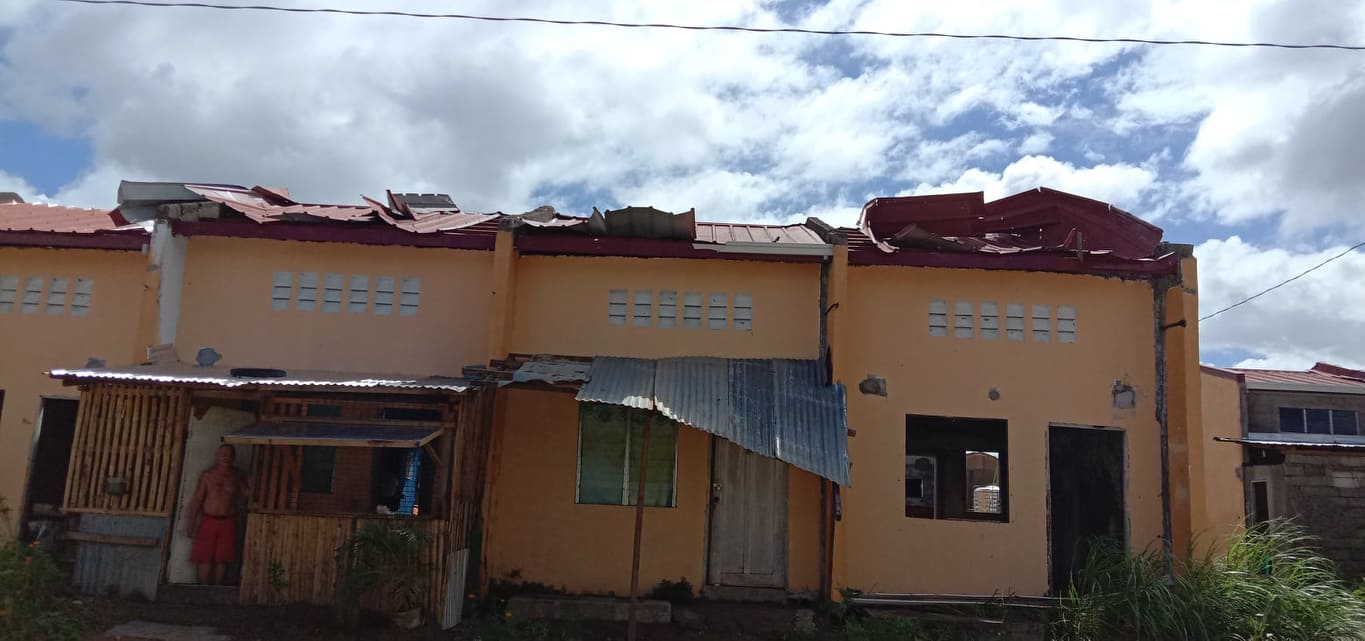In Visayas, gov’t houses no match for Typhoon Ursula

TYPHOON DAMAGE Several housing units in a relocation site at Guadalupe 1 in Tacloban City were damaged after Typhoon “Ursula” battered Eastern Visayas on Christmas Eve. —JOEY A. GABIETA
TACLOBAN CITY—Josefa Barona and her husband, Antonio, thought they were safe inside their resettlement site in Tacloban City during the onslaught of Typhoon “Ursula” (international name: Phanfone) on Christmas Eve.But their sense of security was shattered when Ursula’s strong winds blew off their roof.
“Imagine our situation—an elderly couple with their grandchild inside this house, its roof violently making cracking noises due to strong winds and heavy rain pounding them,” according to Antonio, 64, who has been staying in this relatively new house since their old home in Barangay 88 was destroyed by Supertyphoon “Yolanda” (international name: Haiyan) in 2013.
But the Baronas’ house was not the only unit damaged by Ursula as several resettlement sites for Yolanda survivors in the provinces of Leyte and Capiz were not spared by the recent typhoon’s wrath.
These houses were constructed by the national government, through the National Housing Authority (NHA), and were supposed to withstand strong winds.
Some residents have complained that these resettlement houses, measuring about 40 square meters, were poorly constructed.
Article continues after this advertisementBut Dorcas Secreto, the NHA regional management estate specialist in Eastern Visayas, dismissed these claims, saying the designs and specifications of these houses were submitted by contractors to the Department of Public Works and Highways (DPWH) for approval and scrutiny.
Article continues after this advertisementBad memories
According to Josefa, Ursula brought back their bad memories of Yolanda, which claimed the life of her son, Antonio Jr., whose body was never found.
“I was so nervous because I was afraid it would be another Yolanda,” she added.
With their roof gone, all their belongings were soaked.
Josefa said they didn’t have the money for repairs since the income of her husband, Antonio, a jeepney driver, was barely enough for the family’s basic needs.
Like the Baronas, another Yolanda survivor, Rodolfo Pido, 67, lost his house’s roof to Ursula.
“I was just alone at that time. I kept on moving from corner to corner of the house so I would not get wet because the roof was torn off. I ended up staying in the toilet, where the roof was intact,” he said.
Pido, who depended financially on his children, hoped the government would help him repair his house.It was a different story, however, with residents staying in housing units built by a private foundation.
Families living in a resettlement site constructed by the private sector, like the GMA Kapuso Village in Barangay 106, felt secure inside their houses while Tacloban was being battered by Ursula.
Vincent Reyes, 52, who was originally from Barangay 88, considered ground zero of Yolanda in Tacloban, said: “We knew that our house … would not be destroyed by Ursula. We have experienced several typhoons in the past since we transferred here almost six years ago but our houses were not damaged. We feel safe here.”
In Capiz, Doris Orsal was sad when she learned that the coastal village of Culasi in Roxas City was ravaged by Ursula.
“We still have families there and we know how they feel,” Orsal told the Inquirer at Jumaguicjic Ville, where more than 100 families in Roxas, including Orsal’s, relocated after the supertyphoon battered the city.
Difficult life
But these families were only able to transfer to their single-story units in Jumaguicjic Ville in September 2018 due to delays in the construction of the government housing project.
“Life here is difficult because we have no means of livelihood and it is too far from our only source of income,” she said.“What will you do with a house but you have nothing to eat?” she said, saying other residents were complaining that their roofs leaked and their toilets and sink drains were clogged.
Their houses were not spared by Ursula even if these were made of concrete with galvanized iron sheets as roof.